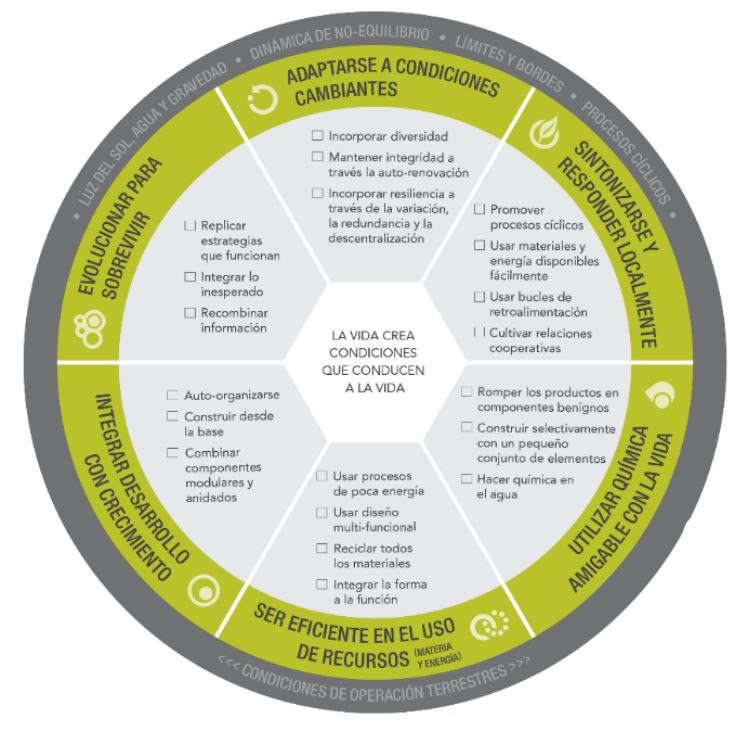admin | 21/07/2020
In a world increasingly concerned with improving production processes as part of industrial sustainability, Biomimetics is emerging as a promising solution for improving the energy efficiency of infrastructure. Inspired by structures found in nature to produce sustainable and innovative solutions, this science is finding increasing acceptance as a building strategy thanks to the development of materials, techniques, and technologies compatible with biodiversity.
“Biomimetics teaches us to study nature as a source of inspiration when responding to our challenges, by looking at the thousands of examples of biological adaptation solutions,” said Marlén López, architect and Director of the Biomimetics Laboratory. She highlights that these strategies are often complex, multi-purpose and highly responsive, yet have a powerful impact on the environment as they require less energy during construction and operation and ultimately produce less waste.
This science has a remarkable future in the architecture and construction sectors, since the general trend in the industry points towards respecting the environment in professional practices. “One of its major challenges will be fulfilling the Sustainable Development Goals (SDGs) in an attempt to minimize environmental impact while responding to the social and energy challenges facing humanity,” said Marlén López.
Despite its promising future, using nature as an inspiration for creating great works is not something new. In fact, renowned architects have turned to nature to design buildings based on the structure of natural organisms: the Crystal Palace, by Joseph Paxton, inspired by the structural patterns of the giant water lily leaf; the works of Antoni Gaudí, featuring constant repetitions of the shapes of living beings; spirals as a form of natural growth and twisted geometry in structures to optimize material efficiency; or the bio-inspired structural design developed by Buckminster Fuller and Frei Otto.
Biomimetic infrastructure

The Glass Palace, located in Madrid’s Retiro Park, is inspired by a 19th century design by Joseph Paxton, based on the structural patterns of the giant water lily leaf
However, in recent years, diverse research has been undertaken to study its application in construction. “Using Biomimetics, we can find solutions in the natural world to build more efficient structures, manufacture materials, create zero-consumption systems, manage resources such as water, control thermal
comfort, and produce energy for buildings,” cites the Director of the Biomimetics Laboratory.
There are a number of examples of biomimetic structures in the world, including:
– The Eastgate Center This building is located in Harare, Zimbabwe and houses an office complex and shopping mall. It takes its inspiration from the internal structure of a termite mound, whereby it replicates a passive ventilation and cooling system. The thermoregulation process consists of reducing heat gain through limited glazing, deep overhangs, and the building’s mass, as well as night cooling through convective air currents. Although these passive techniques do not offer full climate control inside the building, they account for certain benefits such as 10% savings in upfront construction costs as air conditioning systems are not needed or 35% less energy expenditure annually compared to nearby buildings.
– The Gherkin Located in London, United Kingdom, this building imitates the breathing system of sea sponges and sea anemones and features a smart ventilation system that provides air to the whole tower efficiently and reduces energy consumption. It uses a double facade divided into an exoskeleton that is separated slightly from the interior walls to create internal air channels. In summer, the heat that forms inside the building escapes to avoid raising the temperature; in winter, this same ventilation system moves the heat around the building more easily. As a result, the structure creates energy savings of 50% compared to other similar office towers.
– BIQ House Located in Hamburg, Germany, this building features a facade inside where a multitude of microscopic algae live and grow. These organisms control the penetrating light and obtain nutrients and carbon dioxide through a water circuit integrated into the building to promote photosynthesis. As a result of this process, biomass is generated and collected to produce biogas, which provides energy to the building and reduces energy consumption by 50%.
– The Sahara Forest Project Still under development, it consists of high-tech facilities for cultivation, water desalination, and photovoltaic installations, in addition to the reforestation of desert regions. All this is done by interconnecting low-waste emission systems originating from one source: the ocean. This 20-hectare hydrological complex in the desert is expected to produce 130,000 kilos of vegetables per year.
Adaptive technology
Together with other disciplines like sustainability and green nanotechnology, Biomimetics “will be the catalyst for future research and innovation,” providing methodologies and solutions to fields as diverse as medicine, robotics, energy, biotechnology, and artificial intelligence. “Advances in the construction sector will stem from innovation in manufacturing processes and materials, which will make it possible to develop a more sustainable and self-sufficient type of architecture that has the capacity to regenerate and interact with its environment,” the architect asserted.
Nevertheless, the failure to adapt buildings and a reliance on static solutions for facades in the face of changing environmental factors is what accounts for 33% of carbon emissions produced by the construction sector. As López points out, the key lies in the implementation of new and adaptive architecture—a necessary step to improve energy performance, not only at the operational level, but also at the construction, material, and functional levels. This will result in dynamic structures that are able to adapt to surrounding climate and automatically self-regulate thanks to artificial intelligence applications.
Biomimetics has found a major ally in new parametric design software and new manufacturing technologies—such as 3D printing and laser cutting—as these make it possible to create designs inspired by nature while minimizing waste.
Innovation in materials science, “where Biomimetics is increasingly present,” also becomes highly important in this context. In certain aspects, it will define the future of manufacturing and construction, such as the use of active components and sensitive systems with the ability to react to the environment and change shape over time in response to different environmental stimuli.
Future challenges
As in any other discipline, establishing a methodology is fundamental to successful technical implementation of the final product or process. This is especially necessary in the case of Biomimetics because, although the nature-based systems offer extensive options, strategies, and mechanisms for implementation in the design, engineers and architects face the challenge of selecting these natural models and carrying out their technological transfer.
In an effort to make these advances a reality, several research groups throughout the world have committed to the creation of international networks—such as the Institute of Building Structures and Structural Design of the University of Stuttgart—to join prominent architects who are innovating in the field, like Achim Menges, Neri Oxman, and Michael Pawlyn.
The European Union has also supported progress in this discipline by funding projects such as the Hypermembrane-Demo. This project aims to construct buildings with a self-supporting and flexible structure based on ethylene-tetrafluoroethylene membranes, a material that allows the structure to react independently to changes in temperature.
Research and innovation in construction processes and materials envisages a future that is “more organic, sustainable, and naturally intelligent, using systems and materials with the ability to adapt, interact, self-repair, and recycle.” It will also have applications in the field of urban planning, including mobility, organic growth, and the evolving connection between different areas of cities, through evolutionary and organic growth algorithms found in the natural world.
Principles of Biomimetics

Source: Designlens: Life’s Principles, from Association Biomimicry 3.8
 Article contributor…
Article contributor…
Marlén López is a biodigital architect and Director of the Biomimetics Laboratory. She graduated from the School of Architecture of the University of La Coruña (ETSAC) in 2008 and studied a master’s degree in Biodigital Architecture at the School of Architecture of UIC, Barcelona, where she completed her thesis on “Emerging Biodigital Architecture”.
In 2017, she submitted her doctoral thesis entitled “Architectural envelopes that interact with their environment. Naturalizing design,” at the Department of Construction and Manufacturing Engineering of the University of Oviedo, graduating Cum Laude and receiving International Mention by the University College London (UCL).
In twelve years of experience as an architect and researcher in the private and public sectors, she has conducted several architectural and research projects and has recorded more than 300 hours of teaching, publications, lectures, and presentations at international conferences. Furthermore, she has collaborated on several exhibitions and has received awards for her work.





